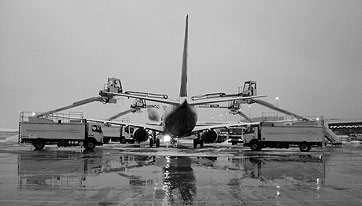
 |
Large volumes of deicing/anti-icing fluids are commonly used during severe winter weather, especially on small- and medium-sized airplanes. |
CLEANING
1. Once identified, the residue should be removed by using warm water with rags and/or soft brushes to hand clean the gel-like substances away. You may also use a low-pressure stream of water or compressed air to rinse away the residue. Make sure the water or compressed air do not cause the residue to enter crevice areas that are not accessible.
Research and experience have shown that the use of Type I deicing fluid, or a mixture of water and Type I fluid, is also a good cleaning agent for removal of residue. Test data indicates that use of a detergent additive with water may actually reduce the cleaning effectiveness.
2. This cleaning process has the potential of removing grease from control system bearings and fittings, and removing corrosion inhibiters from control cables. Care should be taken to avoi spraying cleaning fluids onto bearings, fittings, control cables, and electrical connectors.
The cleaning process also has the potential to wash the residue into other areas, where it may deposit and create a future problem. Attention should be paid to the runoff from the cleaning process into other areas of the airplane, and these areas should also be flushed until the operator is confident that any deicing/anti-icing fluid residues have completely left the airplane.
Similar to the inspection phase, do not spray the controls with water when the ambient temperature is below freezing unless the airplane is in a heated hangar. Doing so may result in ice that impairs the flight controls.
RELUBRICATION
1. If residue has been found and removed by cleaning, Boeing recommends that all bearings, fittings, and control cables in the area that was cleaned should be relubricated in accordance with appropriate AMM instructions.
2. Any areas from which corrosion-inhibiting compound has been removed or depleted by the residue-cleaning process should be retreated in accordance with the appropriate standard overhaul practice manual procedures.
FOLLOW-UP ACTIONS
Operators have reported that it can be very difficult to remove all residue with a single cleaning, and that residue may slowly migrate out of crevices after it is removed from open areas by cleaning. If practical, Boeing recommends reinspection within three days of any areas from which residue has been cleaned, following the inspection instructions above.
If residue is found, additional cleaning is recommended. These inspections and cleanings should be continued on a frequent basis until no additional residue is found. These recommendations are based upon the experience of several operators during previous winter seasons. However, the recommendations are also dependent on the specific schedules for each airplane and the amount of deicing/anti-icing treatments being encountered. Some operators have developed their own maintenance programs to remove existing deicing/anti-icing fluid residue based on their own data.
INDUSTRY ACTIONS
Numerous reports of problems due to deicing/anti-icing fluid residues prompted the formation of a Residues Working Group as part of the SAE G-12 Aircraft Ground Deicing Fluids Subcommittee. Among the group’s responsibilities is the development of improved fluid dryout and residue tests for the SAE Aerospace Material Specification (AMS) 1428.
Also, the SAE G-12 Aircraft Ground Deicing Methods Subcommittee is making new revisions to the caution note regarding residue in the Methods Document, SAE ARP 4737, section 6.3.1.2.
The subject of deicing/anti-icing fluid residues is also under discussion by the European Regions Airline Association.
In the United Kingdom (UK), the Air Accidents Investigation Branch (AAIB) issued four safety recommendations in early 2006 regarding the subject of deicing/anti-icing fluid residues. In response to the AAIB recommendations, the UK Civil Aviation Authority has recently issued Flight Operations Division Communication number 15/2006, which recommends specific procedures for the use of deicing/anti-icing fluids, and for cleaning of fluid residue, on airplanes with nonpowered flying controls. In addition, the European Aviation Safety Agency (EASA) has released Safety Information Notice (SIN) No. 2006-09. This notice includes informationand recommendations regarding deicing/anti-icing fluid residue in section 8, Special Operation Considerations, and section 9, Special Maintenance Considerations. Please note that the SIN is only an advisory document, and further regulatory action may be expected by EASA.
SUMMARY
Service experience by many operators using several different airplane models has shown that use of thickened deicing/anti-icing fluids can result in the accumulation of residue that may rehydrate and expand into a gel-like substance which can interfere with airplane flight control systems. Failure to regularly remove this residue may degrade the performance of the airplane. As a result, these considerations should be part of an airline’s winter operations:
- Be aware of how frequently your airplanes are being deiced/anti-iced.
- Be aware of what deicing/anti-icing fluids are being applied to the fleet. Is the fleet undergoing a one-step or two-step process? Is the process the same at all airports?
- Make sure that proper procedures are being followed by airline personnel or a third-party service provider. Are the fluids being stored and handled properly, and are they being applied properly?
- Establish an inspection and cleaning schedule for deicing/anti-icing fluid residue to ensure no flight control restrictions will occur.
- Include the application of lubricants and corrosion inhibitors as necessary to the areas where residue cleaning occurs.
For more information, contact Joel Hille at joel.d.hille@boeing.com.
